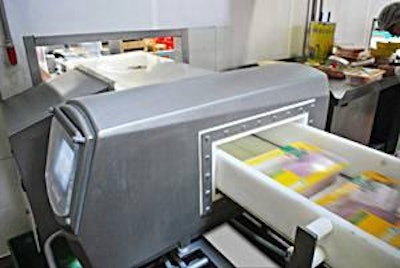
The need to equip meat and poultry processing and packaging lines with top-quality product inspection equipment is more pressing than ever before. Tightened regulatory standards and heightened consumer awareness require that meat and poultry manufacturers take all measures necessary to protect both customers and their brand reputation.
In 2010, the UK Food Standards Agency reported 116 incidents of physical contamination, with 66 percent concerning "extrinsic material not related to the food itself." Thirteen product recall notices were issued. Interestingly, in 2009 the number of incidents was 56, less than half the 2010 figure. In March 2011, for instance, Premier Foods had to recall certain batch codes of two canned meat pie products due to the possible presence of small pieces of glass within the products Also, more recently Windsor Quality Food Company had to recall approximately 11,390 pounds of chicken pot pie empanadas as they contained foreign materials such as plastics.
These figures, and the examples above, are the type of issues that provoke concern amongst meat and poultry manufacturers. There are inevitable and serious consequences in the event of a product recall - the financial cost of sanctions and fines is often high, and can have immediate and long-term implications for a company reputation and share price. Food safety scares can dent consumer confidence to such an extent that affected brands may find it very difficult to recover.
In order to keep customers satisfied and to ensure brand and reputation are protected, certain product inspection steps must be taken. Below is a five-point checklist for the route to the highest-quality product inspection.
Understand the regulations
The first step in satisfying food regulations and standards is to acquire a full understanding of what they entail and which particular ones apply to your organization. It’s important to select equipment and suppliers that can ensure compliance and have knowledge of global and local quality standards, regional differences and industry variations.
Checkweighers, metal detectors, X-ray equipment and vision inspection systems must satisfy legislation implemented by state regulators – bodies such as the Chinese State Food and Drug Administration, Germany's Federal Ministry of Food, Agriculture and Consumer Protection, or non-federal US state regulators – in their ability to guarantee process and product security. In many cases, it is also important to choose technology and equipment that adheres to the demands of the industry, such as standards encompassed by the Global Food Safety Initiative, which includes British Retail Consortium, International Food Standard, Safe Quality Food and FSSC 22000 schemes.
The requirements heaped upon manufacturers do not end with food safety legislation, global certification schemes and process-specific standards. For example, checkweighers play a pivotal role in meeting trading standards like Weights and Measures, and innovative, centralized product inspection device management helps to placate major retailers who have their own, individual sets of standards, such as Tesco and Marks and Spencer – especially in terms of due diligence.
Know your product
Armed with an awareness of relevant regulations and standards, manufacturers must turn their focus to the nature of their product. What are the product density, thickness and moisture content? Is the product wrapped or loose? If it is packed, what sort of packaging material is it wrapped in? Are the products being inspected as individual packs or are they combined as multi packs? These are just a few examples of the questions to be answered. Different combinations can affect the optimum inspection solution.
For complete safety, it is important to understand at what point or points in the production process your meat and poultry product needs to be inspected and which potential contaminants you are looking for at each point.
Product or pack orientation has a similar bearing on the type of inspection needed, as well as product format and positioning as it passes through the inspection system. For example, meat pies may be randomly positioned on a conveyor belt in the production process. In this instance, X-ray technology is first able to locate a recognizable product, and then run an inspection routine. Market-leading product inspection solutions can be tailored to accurately inspect any product format, of any density, in any packaging material.
Part of knowing your own product is understanding the factors that could limit inspection sensitivity. This draws upon knowledge of individual product and inspection technology, potential contaminants and environmental factors. For instance, a meat product could be inspected on a conveyor after packing. The working environment may have space limitations. The solution required may be a metal detector with high detection sensitivity to all metals and which has the ability to be positioned in a limited footprint in close proximity to metal structures and other equipment without interference and impaired performance.
Increase risk awareness
Good manufacturing practices, such as those outlined in a Hazard Analysis and Critical Control Points program, should be in place no matter where or what your company is manufacturing. A comprehensive process audit should be put in place which, in the case of HACCP, requires the implementation of a structured ‘seven key principles’ approach. This procedure involves the systematic identification of manufacturing risks, and the incorporation of means to mitigate the risk when identified. Risk mitigation could include the establishment of Critical Control Points to inspect at points where contamination could have occurred. The process should also include the implementation of a corrective actions program to manage non-compliances. The seven key principles apply across the board, regardless of the product you are producing.
A process audit which follows HACCP analysis principles enables manufacturers to get a grasp on which contaminants are most likely to affect their product, be it metals, glass, bone or plastics, in addition to all product integrity risks on your line. These integrity risks, which require accurate product inspection to control, may include the risk of missing product, broken product, damaged packaging or inconsistent fill levels. Once the initial risk assessment is complete, meat and poultry producers are in a position to better understand which technologies are ideal for their particular risk control requirements.
Optimize productivity
A well-designed product inspection system will maximize product quality and safety. Additional features that deliver key process benefits can be selected to facilitate increased productivity and minimize downtime. These twin goals can be attained by choosing efficient, easy-to-use and flexible equipment, specific to your requirements.
‘Condition Monitoring’ features in metal detectors are a proven method of improving production line efficiency. By identifying potentially adverse trends early on and, crucially, providing advance warning of potential line stoppage to machine minders or maintenance operatives. Systems of this type help to avert detection system failures and improve Overall Equipment Effectiveness. In market-leading inspection solutions, intuitive touch screens provide an easy and efficient interface through which to control process and packing line parameters, speed up the set-up process and provide further productivity boosts.
Easy integration with other surrounding pieces of equipment is also important for inspection machines – this can allow installation time to be kept to a minimum which can in turn increase up-time. Similarly, system options exist to provide flexibility for the inspection of multiple different products at a single machine setting (through the use of ‘change-free’ technology). Different inspection technologies can also be combined in a single, space saving unit for example, metal detector and checkweigher combinations or X-ray and checkweigher combinations.
Key for efficiency is inspection systems that can keep up with the speed of the line. It is important to choose technologies that can accurately and reliably inspect and reject non-conforming products from the line without slowing down throughput.
Rely on the experts
The selection and purchase of product inspection equipment best suited to your line needs can appear, on first sight, a daunting task. With food safety regulations changing continually, there is an added pressure on manufacturers to stay up-to-date with the latest developments, and bring in the latest technologies to meet the new required standards.
To eliminate confusion, and select the most appropriate product inspection equipment, meat and poultry producers need a partner they can rely on. They should be able to call on an equipment provider with the worldwide expertise necessary to give close consultation on optimum systems, corrective actions, and the ability to provide the best product inspection equipment available to carry them out.
One-stop-shops and bespoke solutions are ideal for manufacturers with varying production demands, allowing for the best combination of metal detection, X-ray, checkweighers or vision inspection systems, while also offering the ability to easily ramp up or down as production demands change.
On the path to quality
The choice of the ideal product inspection program can be overwhelming as it depends on a number of factors, from product characteristics to regulations and standards. The five tips above can shed some light on this important decision to ensure quality products, productivity and compliance.




.jpg?auto=format%2Ccompress&fit=crop&h=167&q=70&w=250)












